


 |
 |
 |
| K is for Kaier's: (Sept/2011) The later Kaiers "high profile" cones are common, but this 1930's "J" spout is rare in approximately grade 1 condition and was found by a collector at a yard sale outside Philadelphia around 2000. A Kaiers Brewing family member recalled in 2002 seeing during the late 1930's this label in quart size, but not in 12oz size. It likely was a short run, and has been rarely seen in "on grade" condition. Top |
 |
K is for Kingsbeer from Montreal, Canada: (Sept/2011) Dawes Kingsbeer was one of the brands sold by National Breweries Limited, Montreal, Canada, along with Black Horse Ale, Dow Ale, etc. This Brewery organization had originated in 1909 with the combination of 14 independent breweries, and in 1952, the name was changed to Dow Brewery Limited. This cone top can was sold around 1950, and is relatively scarce compared to most other Canadian cone tops, among which are Black Horse, Dow Ale, Moosehead, Oland's, etc. This cone was in a small Roselle, Illinois collection of cans from the later 1940's and 1950's that was located through a newspaper ad by Bob Myers in 1970. The Kingsbeer flat top with the metallic blue label was distributed around 1960. Top |
K is for Krueger's Beer and Ale: (February/2014) Pictured are two Krueger's brands (with the "s" variation) as examples of the first type of beer and ale can labels that held beer and ale, along with being sold to the general public in the 1935-6 period. Bob Kay (BCCA member) specializes in beer labels and wrote a detailed article on the first beer cans and their surrounding circumstances in the Jan-Feb 2010 BCCA magazine. Top |
|
| K is for Krug: (Sept/2011) The brand was used in 3 cans, two cone variations and one flat top for a liquor store chain in San Francisco. The two cones are slightly different with the rarer variety showing a woman standing. The other variety is similar but missing the woman. Top |
 |
 |
K is for Kuebler Ale: (June/2012) Kuebler Brewing Company of Easton, Pennsylvania operated after Prohibition from 1933 to 1953 on South Delaware River Dr. as pictured below by Ernie Oest in 1952. The company had a number of cans with several label variations in J spouts, crowntainers, a high profile cone, and quarts. Among the brewery's "J spouts", the metallic Kuebler Ale with the graphic "profile" view is rare in top shape. Top |
|
L is for Little Imp: (Sept/2011) A late 1940's metallic can by Southern Brewing in Los Angeles with one of the oddest beer brand names. While different stories on the origin of the name are heard, Ken Jerue (past BCCA member) was told by former brewery workers the story they had heard: a young daughter of an employee visited the brewery occasionally and she was called "Little Imp". During a meeting looking for new brand names, somebody suggested trying "Little Imp" and that brand was started. This is the can pictured in the Class Book by Jeff Cameron. Top |
 |
| M is for M.C. Ale: (January/2014) Mt Carbon Brewing in Pottsville, Pennsylvania (actually located in the borough of Mt. Carbon, two miles south of Pottsville) was a small-sized brewery, but one for can collectors who know its several moderately available flat top beer cans filled in the 1950's-1960's; as well as from the 1930's, its "M.C. Beer" low profile 12oz cone which was also packaged in a rarer quart size. The main brewery building has been torn down but the well-made stone building to the right, or NE, remains.
|
|
| In the early 1980's, collector Don Monroe located a group of c40 cans that included a M.C. Ale low profile cone that most collectors hadn't seen before. The group had been assembled by a 1930's era collector described as "railroader", who worked on trains in Pennsylvania, New York, and Ohio. For several decades the M.C. Ale cone remained very scarce but another on-grade example appeared with its provenance details helpfully provided by its finder: "An M.C. Ale cone and a 12oz. M.C. Beer cone, along with a whiskey bottle were found under floor boards in the unfinished part of an attic during the renovation of a 1937-built house in a Maryland suburb outside Washington." Top |
|
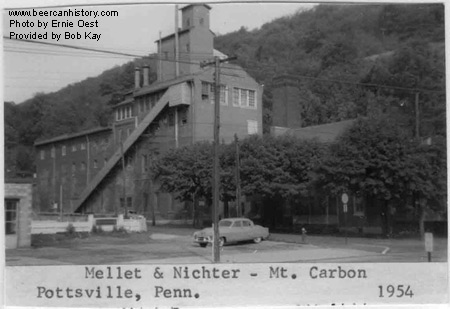 |
 |
| M is for Monogram: (Sept/2011) One of the more colorful Grace Bros cans. For collectors, one of the first times this brand was seen was in the early 1970's at Chip Truett's (former BCCA #826) "Marvin Gardens Bar" display of beer cans in Belmont, Calif. He had found the label among a small group of older cans that had been saved by a collector in San Mateo County. Top |
| M is for Monterey: (Sept/2011) Monterey cones were produced by Monterey Brewing of Salinas, Calif. probably around the 1938 to the early 1940's interval. Prior to 1938, the brewery name had been Salinas Brewing, and was a very small brewery located on Main Street in Salinas. In a ranking of around 33 California breweries as of December, 1936, Salinas Brewing was ranked about 27th and may have had a capacity of only around 5,000 barrels annually. However this brewery did can beer in a cone with an interesting design. The main variation that is mostly seen, is "white" with black in the shield and elsewhere in the label. Also oddly there is at least one slightly cream-colored variation and the two are shown together in the picture. This cream-colored variation would seem to be "smoked", but its history is known and this near-perfect example came from an original collector who started in a small Sierra Nevada town in 1936 and his cans were never in a smoky environment. For most collectors the unusual Monterey cone is the "blue" variation. The early 1990's picture of Gene DiCicco shows him holding the "white" and the "blue" variations. Gene first saw the "blue" variation when finding around 20 "outside" Monterey cones in the Santa Cruz Mountains in the early 1980's. |
Letter from A.K. Neubert, Page 1 Letter from A.K. Neubert, Page2
|
 |
Other collectors said it was only a discolored "white" cone and that a "blue" variation didn't exist. Then a Redding, Calif. collector Charlie Hoyer, who collected with Loren Love, got some cones from a man who worked at the dump in Redding. Included in this group was a clean example of the "blue" variation of the Monterey cone along with others like a Eureka cone. Turns out the source for Charlie Hoyer had worked at the Redding dump during the late 1930's on, and had picked up beer cans he liked. In 1971, California collector Bob Myers wrote the former owner of Monterey Brewing, A.K. Neubert, inquiring on what cans he might have and sending along a picture of California beer cans. A copy of Mr. Neubert's letter is shown, and at that time, Mr. Neubert had relocated to a ranch in Montana, only visiting Calif. once a year or so. He never located any beer cans but sent a Rodeo beer label with a straight flush hand on the back. (Label could be torn off to see the cards' hand.) Mr. Neubert wrote in this letter: |
"The Government stopped me on the use of these because of the expression - 'Don't Gamble, drink Rodeo Beer' - reminded the drinker of the gambling possibilities, and this was illegal." Mr. Neubert highlighted that his brother-in-law, George Ziegler became "one of the big shots of Lucky Lager after he left me in the mid 30's". (Lucky Lager showed steady growth from the 1930's and became the leading California Brewery peaking around the late 1950's and George Ziegler rose to become its brewmaster at that time. The peak year in barrels may have been 1958 when it was the 12th largest brewery in the U.S. with 2,265 million barrels, but the peak year in profits could have been 1956 when it earned over $3 mil. Not many years after that sales were down only a little, but profits plummeted until many years had losses. Details on Lucky Lager from Pat Franco who specializes in the brewery.) |
|
 |
N is for National Brewing Co. (March, 2012) At the O'Donnell and Conkling corner was the National Brewing Co., and across O'Donnell, was Gunther Brewing Co. Since around 1850 there had been breweries in this area which became known as "Lager Brewery Hill".
(Rustycans.com has many more details on National Brewing cans in its Beer Can of The Month for March, 2007, December 2008, January, 2010, and December, 2010.) |
---The picture shows five of the rarer and colorful cone tops that National Brewing used in the 1930s and 1940s. The high profile National Bohemian Bock and the low profile National Beer cones are the rarest ones in the picture, followed by the high profile National Ale and the Old Bohemian. The low profile National Ale is seen more frequently but is still moderately scarce. The Bensonville, IL collection found by #701 Clay Tichelar had the rarest National Brewing Co. cone, a low profile National Bohemian Bock, and also an Old Bohemian cone both of which weren't otherwise known through the 1970s. Later in the mid-1980s per Tom Leo, a dozen or more (?) Old Bohemian cones were found by a dealer, Tony Steffan. Otherwise Old Bohemian cones have still remained scarce and only a few have been found in dumps. (Not pictured at this time are the many can variations of Brewery's lead brand, National Bohemian Beer, which were canned in both low and high profile cones, along with flat top beer and bock cans; in addition National Premium was another brand sold in cones and flat top cans.) ---In the 1930s National Brewing was smaller than several other breweries in Baltimore that also canned beer at the time, Gunther and Globe Brewing Co. However, by the early 1960s after several decades of steady growth, National became the leading brewery in Baltimore selling National Bohemian Beer with the Mr. Boh icon, along with another brand, National Premium. This success was due to the over 900 workers at the O'Donnell plant; Brewmaster Carl Kreitler who made a beer that won local "blind tasting" tests; and the marketing by Dawson Farber, Jerry Di Paolo, etc., who sold the National brands into over 2500 outlets throughout Baltimore's many neighborhoods. National Brewing Co. also bought plants in Michigan, Florida, Arizona and developed several malt liquors, such as Colt 45 in 1963 which grew to a coast-to-coast distribution, along with French 76, and 007 Special Blend - beer and malt liquor. However by the late 1960s the majors with their economies of scale that reduced unit costs, engaged in aggressive price competition along with heavy marketing via television and "behind-the-bar" distributions of glassware, draft beer equipment, etc. These methods added challenges to even a strong regional brewery as National Brewing and it merged with Carling in 1975. As of 2009, the largest remaining building of the former National Brewing complex is the 10 story former Brew House at O'Donnell and Conkling that was built in the early 1950s and is now the Natty Boh Tower. These buildings and others, including ones at the Gunther Brewing location, are part of a 27 acre mixed-use development called Brewers Hill. Top |
|
N is for Nu Deal: (Sept/2011) A name variation on government programs in the Depression by Grace Brothers Brewing of Santa Rosa. Scattered examples of this can have been found such as 4 at the San Mateo Flea Market in the 1970's, and in dumps. Top |
 |
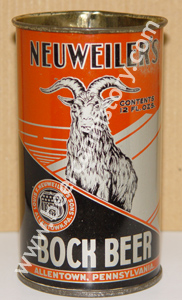  |
N is for Neuweiler's Bock: (Sept/2011) One of two beer cans pictured on the front of the BCCA book, United States Beer Cans. However the cover example may be an "improved" photo of a lesser grade Neuweiler's Bock. |
| Over the years a number of Neuweiler's Bocks have been found in dumps in Northeastern Penn., and reportedly also in New York and Virginia. Among the cleaner examples: a scratched can, that was kept in a workshop to hold screws/bolts; an on-grade example, one of a several mugs, picked up by the neighbor of a man who reportedly had worked at some unnamed brewery. The group of mugs turned up on Long Island in 2007, and the others were: Trommers bock, Senate bock, Feigenspan beer, Ballantine's, and a Dartmouth Reunion Can 1941 - all appeared to be from the around 1940 era. Top | |
| O is for Old Anchor Beer: (March/2012) The Old Anchor J spout from Brackenridge Brewing in that small Pennsylvania town was first pictured in the Class Book, not being shown in any of the earlier main beer can books. In the late 1970s Dick Faletti, an active Chicago area cone collector at the time, reportedly was the first collector to locate a 1/1+ Old Anchor J spout from one of his dealer sources; then around 1981, sold it to Jeff Smith. | 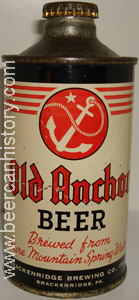 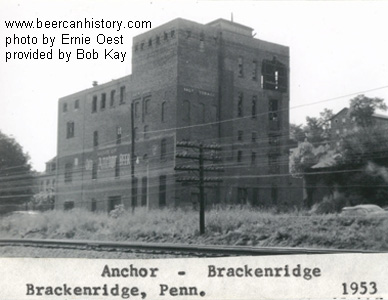 |
| In the late 1970s and early 1980s, because so few of the cones were known, a number of collectors made efforts in trying to locate more. Dick Caughey and John Conradt drove to Brackenridge, making contacts with a number of residents and did eventually turn up two examples around grade 1. Also slightly earlier, Bob Myers ran several of his usual newspaper ads in the local paper and eight persons responded who 30 years and more before, had seen the can, but over a number of months none was able to locate a passable example. The Old Anchor J spout remains scarce in grade 1 and better condition. Due to the enamel label holding up well, the can has been found in very representative examples, technically in grades 2-3, at several dump locations in the 1990's, sometimes in numbers of 3-4 cases or more. Top |
|
| O is for Old Reading "J" spout: (Sept/2011) The Old Reading brand has been canned in a number of beer can types, and the "J" spout version was distributed around the 1940 years. The "J" spout has been scarce in on-grade condition due to the metallic label, and per specialist Marc Tracy, apparently only 4 on-grade examples are generally known: --one was turned up by a dealer in the late 1970's that was gotten by Bob Myers who sold it around 1982 to Jeff Smith; this example could be the one that ended up in the Dave Stark collection. |
  |
--another was found in Penna. during the 1980's and was in Bob McCoy's collection for a number of years. |
|
O is for Oldstyle Lager Beer: (Sept/2011) This label was used on quarts by the brewery in Port Orchard, WA - across the bay south of the Bremerton Naval Yard, but this 12oz can was filled by a brewery in Salem, Oregon. Top |
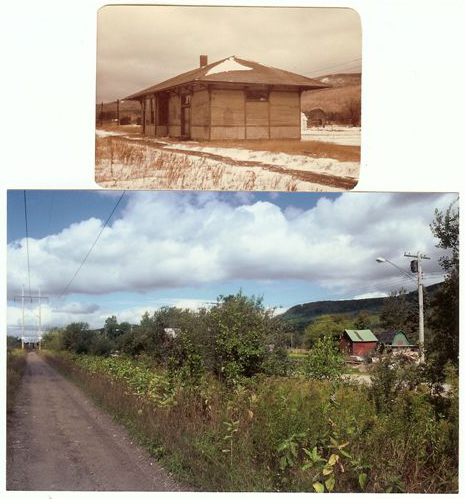 |
Such discoveries are unusual for most collectors, but what the finders did - taking only a few examples of |
|
each brand found and leaving most - was even more unusual from today's perspective when more information is now available on beer cans and collectors who look for them. |
||
A train route in the Northern Adirondack's: In the 1930s and early 1940s, a passenger riding on a New York Central train north out of the Adirondack's to Malone, NY would have seen railroad signs saying Tupper Lake, Saranac Inn, Lake Clear Junction, Gabriels, Stony Wold, Loon Lake, and Owls Head. While no records have been found to verify with certainty, when a train passed the Owls Head station, a NY Central employee might have been seen, but what that employee or others were likely were enjoying in private, probably wasn't generally known - drinking many cans of beer and ale at the railroad station. Advancing to the early 1960s: Will Anderson heard from an Ardsley, NY high school friend about a railroad station in the far northern Adirondack's at Owls Head that had inside what looked to be old beer cans. Will called Bob Myers (later BCCA #26) and the next Saturday they were driving from Ardsley towards Owls Head, going by way of Tupper Lake. South of Tupper Lake they stopped for a break by an abandoned house. Going into the house for a brief look, they found two top shape Utica Club Sparkling Ale cone tops - which now would be called "high profile" cones - and a brand in cans that is still rare today. The can discoveries for that day were just starting... . Reaching Owls Head in the afternoon, they stopped at the Owls Head General Store, and could see the railroad station around 350 feet or so to the NE across the railroad tracks. The inside of station was littered with Railway Express forms, etc., and a few scattered cans, mostly older Pabst brands they hadn't seen before. However, they were disappointed that there were not more beer cans after making the long drive, but Bob happened to look at the waiting room's tall 10-11' ceiling, which had a small, open hatch. Somehow he had the idea to throw a can into the attic. The downbeat feeling at the time changed instantly when the thrown can sounded like it hit metal. Borrowing a ladder from a nearby home, Bob went up first with a flashlight and looked into the dark, low attic. Turning on the light gave the "discovery moment" of which most beer can collectors dream - out of the darkness everywhere appeared metal reflections. Will asked: "What do you see, what do you see?" "Beer cans - piles of beer cans are up here," was the response. The "discovery moment" at Owls Head was history. The attic turned out have stayed dry and the cans, only covered with coal dust, overflowed the wide/deep spaces between the thick commercial-building style attic joists going back many feet from the hatch opening. They spent the next hour crawling around the attic looking to take two examples of each different beer can label they could find. In total they found two examples of about 18 different beer cans in top shape : Fitzgerald's Ale - what would now be called a "J spout"; two different Milwaukee Club cones, now called "high profile"; three different Beverwyck Ale cones, now called "low profile"; Old topper crowntainer; Red Fox Ale "low profile" cones; and a very few of the rarest can found, Haberle's Congress Beer in the "high profile" variety. Also flat top cans were found that turned out to be mostly pre WW II cans, Ballantine's Ale; Feigenspan Amber Ale; PON Ale, Pabst Beer; Pabst Old Tankard Ale; Rams Head Ale, Krueger Ale; Genesee Liebotschaner Beer; and a few Genesee Beers with the white label from the later 1940s. Why were only two cans of each label taken?: While making such "finds" have been rare among collectors, taking only a few examples and leaving hundreds, or more, cans in the attic - is beyond imagination from today's perspective. During that first time seeing the cans they didn't know any other collectors, so saw no reason to take more than two of each label since they were beer drinkers who piled cans up for fun and weren't hoarders of "stuff". (In the following year, Will and his wife Sonja visited Owls Head a few times when vacationing in the Adirondack's, but only took a few more of several brands.) Sidelight of the coal dust on cans: When Will returned to his apartment house, he cleaned the cans in a utility sink. His woman landlord walked up and said: "I have been watching you - you are washing dirty beer cans. I don't want anybody who washes dirty beer cans in my good building. Pack your things and move out." Will takes some of the Owls Head cans to the first gathering he attended of beer can collectors: Several years later, Will read a newspaper article about Joe Veselsky of Hicksville, Long Island who had occasional meetings of beer can collectors at his home. Will stopped by, taking a few of the Owls Head cans. He was surprised that several collectors wanted to buy all the cans he had, and thought to himself: "I know where hundreds and hundreds of these are." The next weekend Will and Sonja made the drive up to Owls Head with the plan to take out all the cans in the attic.
Will described what happened: "Upon reaching Owls Head, I quickly parked by the general store to get some beer nuts. Walking back to the car, Sonja called out, 'where is the railroad station?' I said quickly: 'don't you remember' - it's over there... , pointing away from the store. However, when actually looking in the direction of the station, I didn't see the station either. Upon walking over, we found the station had been bulldozed, buried in hole, and the debris was mostly covered over with dirt - leaving only broken pieces of wood and roofing to see. Our expectations for an easy gathering of clean beer cans to sell were shattered. The shock of finding the railroad station had been buried took away any interest we had to start digging into the debris trying to finding some beer cans." The Owls Head "find" of cans furthered Will's interest in older beer cans and related collectibles: While today only a few of the Owls Head railroad station's cans have continued to be "rare," Will Anderson went on to accumulate many more beer cans, and expanded to collecting "Breweriana" - a word he coined in 1969. He has published over 10 books on the subject: ---Anderson's Turn of the Century Brewery Directory (1968) ---Beers, Breweries, and Breweriana (1969) ---The Beer Book (1973) ---reprinted Hundred Years of Brewing (1973) ---The Breweries of Brooklyn (1976) ---The Beer Poster Book (1977) ---Beer U.S.A. (1986) ---From Beer to Eternity (1987) ---Beer New England (1988) ---The Great State of Maine Beer Book (1996) ---and foreword to New England Breweriana (2001) (For beer can collectors specifically: Beer, Breweries, and Breweriana, The Beer Book, and The Breweries of Brooklyn books, show most of the cans Will accumulated from the Joe Allis collection and other "finds". Most of his breweriana collection was sold in the early 1980s, as he focused more on writing books about Diners, State of Maine persons, history, and activities, etc.) Update with a late 1990s photo taken in Owls Head: The top photo was taken by Will Anderson around 1964 shows the Owls Head railroad station at the time. The second photo shows the location in the later 1990s, but compared to the 1964 picture, is not angled as much across the former railroad right of way. The dropping ridge line of the mountain in the distance matches approximately in both pictures. Dave Lang says Will Anderson long ago told him about the location and Dave checked it out but couldn't locate the pit. He doesn't think a metal detector would work well in that location due to scattered pieces of metal debris along the former railroad right of way. Are there remaining cans still buried at that location? With the numbers of Beverwyck cones around, there is a chance someone long ago could have picked up many from the location. Maybe someone has heard of other times when beer cans were found at the Owls Head railroad station? Top |
||
| P is for Penguin: (Sept/2011) While most Horlacher brands are commonly found, Penguin brand in cans has rarely been dug and few on-grade examples are known, including several (?) rolled examples. For a documented purchase of the brand, Will Anderson in October, 1961 picked up two Penguins, keeping one which was sold with most of his cans around 1982; and passing the other on to Bob Myers - the one pictured which has Penn. tax stamp. As a possible help in digging others, Will doesn't recall for sure which town he bought them, but probably in Hancock, New York along old Rt 17. |  |
| A reference to the brand is in an early 1980's Beer Cans Monthly: a "Virginia" collector is noted as digging some Penguins but a location was not given. Top | |
| P is for Peter Doelger: (October/2013) The Doelger family brewing company, after the late 1850's was located around 407 E. 55th St. The brewery grew to be a major New York City brewery eventually owning most that city block, and per NYFoodMuseum.org, became the "11th largest brewery in the U.S. in 1895." By Prohibition the brewery, with its real estate holdings adjacent to 55th Street and Sutton Place South (formerly Avenue A), was in a neighborhood along the East River that had changed over several prior decades from a mostly commercial district to high-end residential. (A number of New York City brewing families such as Schaefer, Ehret, and Ruppert owned plants that originally were built in mostly commercial areas around Midtown and the far upper East Side - during times when such locations were well north of Manhattan's early population centers. As the City expanded northward, these families benefitted, not only with their expanding breweries, but from the rise in the land values under their brewery buildings.) |
|
 |
 |
| In "Beers, Breweries, & Breweriana" (1969), for his Peter Doelger Brewery topic, Will Anderson commented on the last years of the brewery: "after Repeal the company reopened at 505 W. 125th St., and in 1937 moved operations to Harrison, New Jersey, remaining there until 1948, when they closed down." That location had been the site of the former Hauck Brewery, and at least one marriage had taken place between members of the Hauck and Doelger families. At the Harrison, New Jersey location first were canned Peter Doelger Ale, Beer, and Bock opening directions cans; followed by the metallic Peter Doelger First Prize Beer w/IRTP, and its rarer "Withdrawn Free" variation - a photo of the can's back is shown in the horizontal photo. |
 |
| For the Peter Doelger Beer OI can, Rustycans.com in that site's "Can of the Month" for November, 2007 gives an extensive background on the can and the brewery. The Peter Doelger Bock and Ale cans have only been found in limited numbers. The Peter Doelger Bock pictured was part of a group of "159" cans found by a "casual collector" who became known to more collectors c1980. Dale Rogalski, a dealer at the time, bought the cans and sold most of them over the following year or so. This "find" was written up in the April/May 2007 BCCA magazine by Matt Menke who learned the collection contained mostly Eastern flat tops, cones and quarts from 1935 to the early 1950's, but also had selected brands from across the country, too. Matt heard that the "casual collector" gave the story that some time before 1980, he had been at a dump and saw a load of beer cans being left. He retrieved a number of them that he liked, but left many others. In the article, Matt wrote: "there was no word on exactly" where the dump was (except the state connected with the group's story is "New Jersey") or "what circumstances might have caused" the discarding of a diversified collection with many unusual cans from over a 15 year interval. The Peter Doelger Ale pictured was bought in the 1990's by Ken Ostrow at a New Hampshire show from an antique dealer who found it during his working travels in the New England/upstate New York region. Top |
|
 |
P is for Pilser's brands: (Sept/2011) Pilser's Brewery (location of the pre-Prohibition A. Hupfel Brewery) was in the Bronx and in the 1930's produced three "J spouts", Pilser's Ale, Beer, and Half and Half which are scarce in on-grade condition, with the "Beer" being the rarest. Old Dutch Brewers of Brooklyn (the first brewery for the Hertzberg brewery group per Will Anderson's "Breweries of Brooklyn") bought the former Pilser's Brewery and both locations operated until 1948. The Hertzberg group also bought the former Fidelio Brewery in Manhattan at 1st and 29th streets, operating it under the Metropolis name from 1946 to 1953 - among these breweries a number of brands were produced. Per Tom Leo, two of the rarest Pilser's brands are flat tops: the IRTP gray "beer" from Old Dutch in Brooklyn and the "bock" from Metropolis in New York. Since the Pilser's Bock has no IRTP statement, apparently it was produced in Manhattan's Metropolis Brewery some time around or after 1950 during that brewery's last years - which explains the can's rarity. (The Hertzberg brewery group produced a variety of Old Dutch cans in Brooklyn and later a number of other brands in its many breweries outside New York City. One of those was the "Bock Brand" that continued the same goat design as in the Pilser's Bock.) |
|
| This Pilser's Beer "J" spout is rare with just a few on-grade and the one pictured was from the Joe Allis collection which then went to Will Anderson. It is pictured in several of his books, such as the 1969 loose leaf publication "Beers, Breweries, & Breweriana". That book has some of the earliest pricing of beer cans: routine cans were listed at $.25; medium cans at $1-2.00 and the rarest, such as Gibbons Bock, at $3.00 to $3.50. The less rare Pilser's Ale cones have been found since the 1980's. Top |
||
 |
||
 |
||
| P is for P.O.S. cone: (January/2014) The P.O.S. cone contained beer brewed by the small Philadelphia Brewing Company in the 1940's. The brewery went out of business in 1949 - one of c175 breweries in the U.S., mostly "local" breweries, that disappeared during the years from 1948 to 1955. While small in size, the brewery had been in operation going back to 1864, and during these years was mostly located at Sixth and Clearfield Streets. Interesting background on some of the brewery's activities and advertising is described in an article by Rich Wagner "The Philadelphia Brewing Company - A Well Traveled Name" (Mid-Atlantic Brewing News, February/March 2008). For many years until Prohibition, Philadelphia was a brewing center second only to New York City (when Brooklyn is also included) in numbers of its breweries. |
 |
| Continuing the City's long brewing tradition, another "Philadelphia Brewing Company" is open to the public in the Kensington neighborhood, within a few miles of the brewery that canned P.O.S. beer over 60 years ago. |
|
| R is for R & H Special XXX Ale: (January/2014) Rubsam and Horrmann Brewing Company was on Staten Island at a location where a brewery had been since 1854, 191 Canal St. Stapleton, Staten Island. The brewery grew well after Prohibition ended, becoming one of New York City's larger breweries with a capacity of 850,000 barrels in 1950. However shortly later in 1953, R & H was another of the c175 brewery names that went out of business during the 1948-1955 years. The brewery plant was bought by Piel Bros. which canned, until 1962, its Piel's beer brand of the time labelled as "Staten Island." |
|||
Will Anderson has related that in the mid-1970's, he was checking out the closed and mostly empty-appearing brewery when, two security guards drove up to his car inquiring what he was doing. He said he was an historian of breweries and had written several books, which he showed. After his explanation, Will said the guards drove away ending what was his closest call when visiting many closed breweries over the years. Fortunately the guards arrived after he had made several trips to his car having already put in his trunk a number of china pieces with "Rubsam and Horrmann" and other misc. items that had been scattered on a floor in the brewery. |
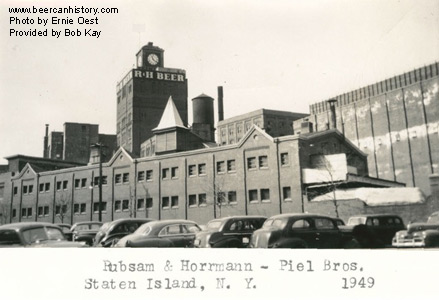 |
||
| R & H had a small line of flat top ale and beer cans, starting in the late 1930's with R & H Special Beer and R & H Special xxx Ale. The R & H Special xxx Ale is thought to be the rarest can from the brewery and is pictured. While some uncertainty on the numbers of this label that are around, there appear to be at least three examples: (The can was first seen by collectors in the Class Book (1984.) ---An R & H Special xxx Ale, with uncertainty on the condition, was in the "New Jersey, 1980" find written up by Matt Menke in April/May 2007 issue of BCCA magazine. ---A second R & H Special xxx Ale can in top shape was found by Tom Leo, BCCA member, at a Brimfield show in the mid-1980's. ---A third example is thought to be around, that could have been (?) originally in the John Paul collection, but uncertainty on where it was found and its condition. (The David Stark collection had an R & H Special xxx Ale that was graded as "1/1-" and it is either the first or 3rd example above.) Top |
|||
R is for Rainier Brewing Company (SF) at 15th and Bryant, San Francisco: (May/2016) During the 1930s and early 1940s, Rainier was the second largest brewing company in California selling widely its main brands, Rainier Special Export Beer, Rainier Club Beer, and Rainier Old Stock Ale, cones of which generally have been found in large numbers. Also of interest to collectors are Rainier Brewing Company's dozen or more, mostly rarer “store brands," which were canned in a number of label/can-type variations. At that time, wholesalers were a key part of the distribution chain from producers to retailers. During this period, Rainier Brewing was California's most active/large scale producer of canned beer "store brands" provided by wholesalers to many small stores; along with brands sold with the names of market chains, such as "King's Taste" at Hagstrom's Food Stores which were mostly in the Oakland and East Bay areas.
|
|
(Rustycans.com has background information on Rainier Brewing Company in that site's April 2008 "Can of the Month" - a B & B low profile cone. That site also has an extensive topic on “store brands” canned by breweries across the country: click on “sitemap," then “history," and “store brands.”) In the picture is a rarer flat top can that had the "Rainier" brand, which is dated March 26, 1941, and likely had a short-canning interval. It was originally located by an active Chicago collector in the later 1970s, Dick Faletti, who passed the can on to Dave Stark. The other cans pictured are a selection of the mostly lesser-seen "store brands" filled during the 1930s and early 1940s. All of these cans pictured have been found in dumps, though in limited numbers for the rarest ones: Silver, Leidigs, and Krug/with woman cones; Rainier, Lifestaff, and Pilsen Brau flat tops. |
|
| The rarest of these dumpers is the one Silver dumper example that has been found, so far (photo at side). It was located by Bob De Camp in the late 1980s who described the “find" to Glenn Hintz and provided the photo here: |  |
Not included in this picture are other brands in cones Rainier Brewing sold such as "B & B" cones which are shown and described with details in the Rustycans.com article above; along with other cones having many variations of the Rainier, Lifestaff, Pacific, and Tacoma brands that are pictured here, in their rarer variations as flat top cans. |
|
| Rainier Brewing Company was sold to Hamm's in 1953, which continued operations at the same location until 1973. In October, 1975, the former brewery buildings' contents - from contents in the offices to canning equipment to vats, etc. - were auctioned off over several days. (The cover page of auction booklet and another page are shown below.) In the 1980s for several years, large holes were seen in the upper floors of the former brewery building that facilitated removal of the vats and other equipment. With the walls and holes repaired now, but with many more/larger windows, externally the various structures of the former brewery complex look remarkably similar to how they looked in the 1930s. - Rustycans.com has a 1930s photo view. Top |  |
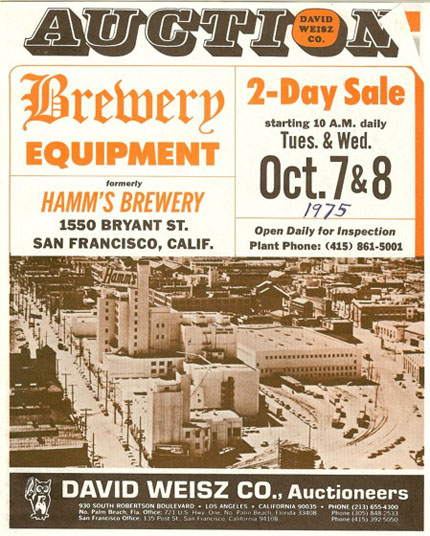  |
|
| R is for Red Lion Ale: (Sept/2011) which in the picture is paired with the Burger Beer low profile cone from Burger Brewing Co., Cincinnati, Ohio - "vas you efer in zinzinnati" and having a comical-looking camel shown. Red Lion Ale was one of the first cones filled (the most common variety has the flat bottom) and also ranks among the most graphic of beer cans. Burger Brewing continued operating until 1973 as a strong regional brewer that had many cone and flat top designs, but only a couple of its later brands approached the colorful graphics of the early Red Lion Ale low profile cone: --its late 1940's Burger Brau cone showing a Germanic-appearing beer drinker with a green hat holding a beer stein. --a Red Lion Malt Liquor tab-top issued just a few years before the brewery closed. |
|
| Before Prohibition the predecessor brewery name to Burger was the "Lion Brewery", which prominently highlighted a lion, and also several in a group, in its advertising. When starting cans in the mid 1930's, Burger management likely wanted to continue with the Pre Prohibition local icons, but must have quickly found that 1930's beer drinkers didn't connect with the "Lion" icon for some reason, as had past generations and the brewery moved ahead with new marketing approaches. ---Regarding the comical-looking camel shown on the Burger cans, thanks to historian Mark Benbow, Ph.D for background information: |
 |
Burger Brewing also has its name on a large-sized can showing a camel with the words on its saddle blanket: Are you thirsty? Before and during Prohibition, unhappy camels were used such as in the picture with the words: Lansing is Dry! Oh ' Whats the use? At home, I sometimes had to go without a drink for ten days. Here I can never get a drink when I want it. Quoting Dr. Benbow, who has more information on the subject: "It's a swipe at the Prohibitionists. The "Are You Thirsty?" slogan fits perfectly. The Drys used the camel as one of their symbols in the years before 1919 (along with an umbrella), but so did the Wets. Generally if it looks thirsty its from a wet place, if not, then its pro-dry." Top |
|
 |
R is for Rheingold - McSorley's Ale and Pale Double Bock: (Sept/2011) Leibmann Breweries, Inc had many beer can labels, most under its Rheingold brand with the Rheingold Girls group of cans being the highlights for the general public. In 1964 as the long time Brooklyn-based brewery was approaching its last decade, the name was changed to Rheingold Breweries, Inc. and in 1965 it peaked at #8 among U.S. brewing companies. Two of the brewery's specialty brands were McSorley's Ale and Rheingold Pale Double Bock. McSorley's Ale has been rare when packaged in cans. To date the only multiple "find" of fully on-grade McSorley's Ale cans was by John Paul, a '60's-'70's collector in Cincinnati. John's beer can collection was "made" with one collection he bought in 1971 in the Akron, Ohio area. |
|
There was a brief article in BCCA magazine not long after his find and more details on this collection is towards the end of the Greater New York Brewing topic in ABC's of Cans under, "John Paul and his collection in Cincinnati". Among the "170" cans John Paul found were two New Yorker cans, the Beer and Half and Half; Clipper cone; and two McSorley's Ale cans. The Joe Veselsky collection and a couple of other early collectors had McSorley's Ale, but most examples now are typically well off-grade due to the metallic label. The Rheingold Pale Double Bock has been similarly scarce and was in the Will Anderson collection, with a picture of the can in one of his first books, Beers, Breweries, and Breweriana (1969). Top |
||
| [Back to Home] | |
| Copyright © 2007-2014 www.beercanhistory.com, All Rights Reserved. Last modified February 9, 2014. | |